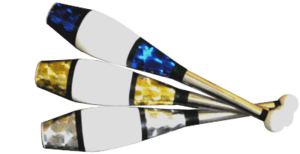Juggling club facts for kids
Juggling clubs are special items used by jugglers. Jugglers often just call them clubs. People who don't juggle sometimes call them pins or batons. Clubs are one of the three most popular items jugglers use. The other two are balls and rings.
A typical juggling club is about 50 centimetres (20 in) long. It weighs between 200 and 300 grams (7.1 and 10.6 oz). The club is thin at the "handle" end. Its balance point is closer to the wider "body" end.
Juggling clubs look a bit like bowling pins or Indian clubs. But modern juggling clubs are different. They are made from different materials. Their weight and how the weight is spread out are also different. This means you usually can't use a bowling pin for juggling.
Contents
Types of Juggling Clubs
Juggling clubs are made from different materials. They are also built in different ways. This means there are a few main types of clubs.
Wooden Clubs
In the early 1900s, clubs were made completely of wood. They had solid handles. Their large bodies were hollow inside to make them lighter. These clubs were often called American-style juggling clubs. This was because of their size and shape. In Europe, clubs were made with solid cork bodies and wood handles. Some were very thin, solid wood clubs, more like sticks.
Plastic Clubs
When plastics were invented, it became easier to make juggling clubs. This led to many different sizes, shapes, weights, and colors of clubs.
One-Piece Clubs
One-piece plastic clubs are made as a single molded plastic item. The handle and body are from the same material. The club is hollow. One-piece clubs are very strong. They are also cheaper to make and buy than other types. But jugglers don't like them as much as multi-piece clubs. This is because the handles are not flexible. They can sometimes hurt when caught.
Multi-Piece Clubs
Multi-piece, or composite, clubs are made from several parts. These parts use different materials. The center of the club is an inner rod. This rod is usually wood, but sometimes metal. It gives the club a strong, even shape. The body of the club is a single molded plastic shape. The handle is a wrapping of thin, flexible plastic or cloth.
The wrapped handle makes these clubs easier to catch. This is helpful during long juggling sessions. Foam ends are put on the top of the body. Round or cone-shaped knobs are at the base of the handle. These protect the club's ends from hitting the ground. This design was first made by Jay Green in the 1960s. Brian Dube improved it in 1975. Multi-piece clubs come in a thin European style or a larger American style. They are usually 19 to 21 inches (480 to 530 mm) long.
Club Decoration
Both one-piece and multi-piece clubs are often decorated. This is done with colored tape. Or they have special designs from the club makers. Decorations can cover the whole body and handle. They come in many colors, including glitter. "European" decorations only cover parts of the club.
Basic Juggling with Clubs
The most basic way to juggle clubs is called the cascade. This is like juggling balls. Clubs are thrown from one hand to the other. Each club goes under the other clubs. It is caught by the hand opposite to where it was thrown. Usually, each club spins once per throw. But jugglers often do double, triple, or even more spins.
Juggling Tricks
Many different tricks can be done with clubs. These go beyond the basic cascade pattern. Most tricks done with balls can also be done with clubs. However, they are usually harder to learn. This is because clubs are bigger. Their spinning also adds more challenge. But for some tricks, like juggling while riding a unicycle or blindfolded, clubs can be easier. This is because you don't need to be as exact when catching them.
Unique Club Tricks
Juggling clubs are used for special tricks that can't be done with balls or rings. Some examples are chin rolls, helicopter spins, and different types of traps. There are also unique throws because of the club's shape and spin.
A flourish is a trick where a juggler spins the club around their fingers. The club spins twice around its center of balance. Once it spins on the inside of the hand, and once on the outside.
Passing Clubs
Clubs are the favorite item for passing between jugglers. There are many reasons for this. Clubs have a larger area to catch than balls. Also, you can do more different tricks when passing clubs than with balls or rings. Clubs are also more exciting for an audience to watch.
When beginners pass clubs, they usually use six clubs between two jugglers. Each juggler passes one club to their partner every four beats. The clubs are passed from one juggler's right hand to the other's left hand. So the clubs travel straight across between them. This basic pattern is called "four count" or "every-others."
More advanced club passing can use more clubs, more jugglers, and more complex patterns. There are special ways to write down club passing patterns. One is called causal notation. Another is "four-handed siteswap," which is a type of siteswap.
Combat Juggling
Combat, also known as Gladiators in Europe, is a popular group competition. It's a "last man standing" game. Jugglers must keep juggling a basic three-club cascade in a small area. If a juggler drops a club or goes out of bounds, they are out of the round. They must leave the playing area.
The rules for combat juggling can be different in various countries or at different juggling events. Usually, players are not allowed to touch each other. But they can use their clubs to mess with other players' juggling. Many rounds can be played. The winner is the first to win a certain number of rounds. Or it's the person with the most wins by a set time.
World Records
The world record for juggling the most clubs for the longest time is eight clubs. This record is for 16 catches. Each club must be thrown and caught at least twice without dropping. Anthony Gatto set this record in 2006. Willy Colombaioni matched it in 2015.
The record for flashing the most clubs is nine. Flashing means each club is thrown and caught only once. Eivind Dragsjø achieved this in 2016 with 11 catches.
See also
 In Spanish: Maza (malabarismo) para niños
In Spanish: Maza (malabarismo) para niños



